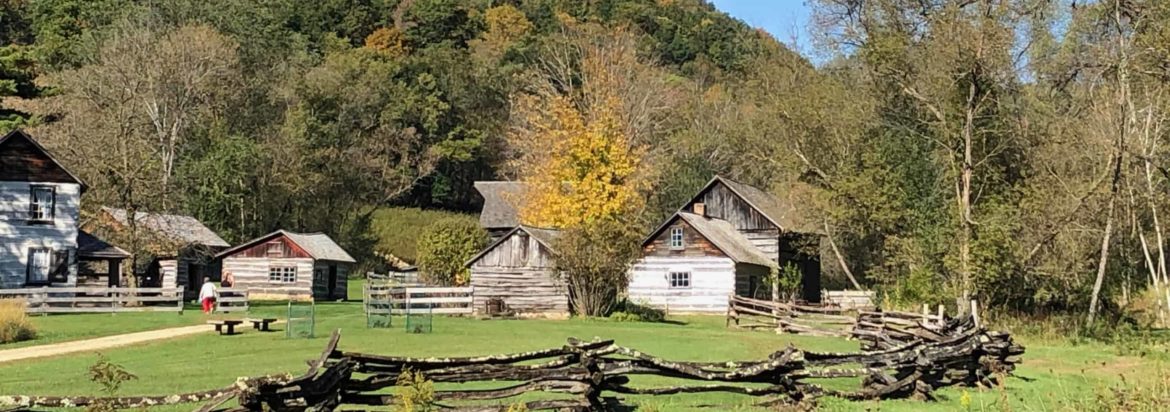Sometimes a person just needs to ignore the drudgery of the “to do” list and leave their burdens and worries behind. I took this advice and spent a carefree day “drifting” along with a group tour. I intended to set all worries aside and enjoy Wisconsin’s scenic driftless area.
In the capable hands of an expert tour guide, driver, and a woman in charge of our comfort, I settled back in the cushy bus and let all my worries drift away. “Driftless Wanderings” is part of Able Trek’s “Go places and learn stuff” series and learn I did. Our tour guide, a retired geology and biology teacher, began by pointing out Sauk County’s Ableman’s Gorge, a fascinating nature area near Rock Springs. My husband and I discovered the gorge a year ago when the pandemic encouraged us to seek new adventures that were nearby. The quartz cliffs rise 200 feet above the Baraboo River to form a wall that extends nearly a mile. I think of it as a mini Zion National Park.
Our comfort lady offered cold bottled water, and we continued on to simply soak up the beauty of the sunlit orange, red, soft green, and yellow hills of Reedsburg, LaValle, Union Center, and Mt. Vernon. I found myself unwinding as we passed a slow-moving Amish horse and buggy in Cashton. Ah, yes. Soaking up the charm and beauty of our state was exactly what I needed.
Our first stop was the Norskedalen Center near Coon Valley, WI. I’ve wanted to explore this Norwegian nature and heritage center ever since hearing about it. And indeed, as soon as I stepped out of the bus and saw the various buildings built in the mid-1800s and tucked in the hills near a stream, I thought of gatherings at my grandma’s. I could picture the family sipping coffee, smell the baking lutefisk, and taste her famous poppyseed cake fresh from the oven.
I zeroed in on a volunteer who looked so much like a younger version of my grandma, I wanted to give her a hug. “Yeah,” she would say, in that same lilting sing-song way. The woman described what could have been my great-grandmother’s childhood as she pointed to the black cast iron cooking stove, described heating bathwater, and living in a crowded single room with bedrooms in lofts above. She also pointed out how women often added beauty to the home through rosemaling or designing quilts. When she explained that Norwegians rarely seasoned their foods, something I’d never heard before, it helped explain why I’ve never been a fan of strong or hot seasonings. How fascinating.
A volunteer working the bellows in the blacksmith’s building looked so much like my uncle and Per Moen, a relative I met in Norway, I had to ask his name and whether he’d been back to the home country. “Twenty-one times,” he said. “It’s in one’s blood, you know.”
When I spotted the sun filtering in through the cracks of a corn crib, I headed toward it. Nearby sat an old corn sheller. As a child, I often had to feed the corncobs into the machine while my father spun the wheel. Once I got stronger, I graduated to working the wheel myself and bringing the shelled corn to our chickens and ducks. This corn crib looked identical to the one of my childhood, except for the fact that it was set on rocks. Ours was mostly flat on the ground, although a wild cat once managed to nestle underneath it to have her babies. My sister and I played inside the corn crib, using it as a clubhouse. Often, when I went inside, I’d hear the scurrying of mice. Despite that memory making the hairs at the back of my neck stand up (I’m not keen on mice) the corncrib sent a wave of soothing, nostalgic memories my way.
Since it was a picture-perfect day in the 70s, our group got to dine in an outdoor shelter where we could soak in the view of this Norwegian settlement tucked into a coulee. I made several Christmas gift purchases at the gift store before regretfully waving goodbye to my “kinfolk.” I settled myself back in the comfy bus for more adventures and learning opportunities.
Our next stop helped me keep my own troubles in perspective. We traveled to the site where soldiers massacred Black Hawk’s people. I’m still haunted by the clip in the Great River Road Interpretive Center’s video of Native American babies crying, about to endanger the lives of their people by alerting the soldiers. Their mothers had to choose between their baby’s life or that of their people. The video showed a woman setting her infant in a small raft and pushing it out into the river. My measly worries paled in comparison.
Our last stop was Genoa’s fish hatchery. Watching the various species of fish including walleye, sturgeon, and crappies, swimming serenely in aquariums was a relaxing way to conclude our events. We ended the tour with a lovely, carefree “driftless” drive along the Mississippi River. Restored, I returned home, ready to face tomorrow’s duties.


2 Replies to “Carefree and Driftless”
I’d love to see the fish hatchery! What is the purpose of the hatchery? To restock lakes? Thanks for sharing your adventure.
Hi Sue,
Genoa raises several different sport fish species and ships them to various states. It’s a fascinating place.